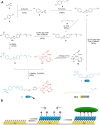Reversible Self-Assembled Monolayers (rSAMs): Adaptable Surfaces for Enhanced Multivalent Interactions and Ultrasensitive Virus Detection
- PMID: 29202022
- PMCID: PMC5704293
- DOI: 10.1021/acscentsci.7b00412
Reversible Self-Assembled Monolayers (rSAMs): Adaptable Surfaces for Enhanced Multivalent Interactions and Ultrasensitive Virus Detection
Abstract
We report on the design of pH-switchable monolayers allowing a reversible and ordered introduction of affinity reagents on sensor surfaces. The principal layer building blocks consist of α-(4-amidinophenoxy)alkanes decorated at the ω-position with affinity ligands. These spontaneously self-assemble on top of carboxylic acid terminated SAMs to form reversible homo or mixed monolayers (rSAMs) that are tunable with respect to the nature of the head group, layer order and stability while featuring pH responsiveness and the dynamic nature of noncovalent build assemblies. We show that this results in a range of unique biosensor features. As a first example a sialic acid rSAM featuring strong lectin affinity is here used to sense hemagglutinin and influenza virus (H5N1) at the pM and fM level by in situ ellipsometry in a fully reversible fashion. We believe that the rSAM concept will find widespread use in surface chemistry and overall for boosting sensitivity in affinity biosensors.
Conflict of interest statement
The authors declare no competing financial interest.
Figures





Similar articles
-
Heteromultivalent Ligand Display on Reversible Self-Assembled Monolayers (rSAMs): A Fluidic Platform for Tunable Influenza Virus Recognition.ACS Appl Mater Interfaces. 2024 Jan 24;16(3):3139-3146. doi: 10.1021/acsami.3c15699. Epub 2024 Jan 10. ACS Appl Mater Interfaces. 2024. PMID: 38197122 Free PMC article.
-
A Reversible and Dynamic Surface Functionalization for Fluidity Controlled Multivalent Recognition of Lectins and Bacteria.Adv Sci (Weinh). 2025 Jun;12(22):e2416658. doi: 10.1002/advs.202416658. Epub 2025 Apr 26. Adv Sci (Weinh). 2025. PMID: 40285667 Free PMC article.
-
Reversible Self-Assembled Monolayers (rSAMs) as Robust and Fluidic Lipid Bilayer Mimics.Langmuir. 2018 Apr 3;34(13):4107-4115. doi: 10.1021/acs.langmuir.8b00226. Epub 2018 Mar 23. Langmuir. 2018. PMID: 29553755
-
A Dynamic, Supramolecular View on the Multivalent Interaction between Influenza Virus and Host Cell.Small. 2021 Apr;17(13):e2007214. doi: 10.1002/smll.202007214. Epub 2021 Mar 7. Small. 2021. PMID: 33682339 Review.
-
Self-Assembled Monolayers: Versatile Uses in Electronic Devices from Gate Dielectrics, Dopants, and Biosensing Linkers.Micromachines (Basel). 2021 May 17;12(5):565. doi: 10.3390/mi12050565. Micromachines (Basel). 2021. PMID: 34067620 Free PMC article. Review.
Cited by
-
Heteromultivalent Ligand Display on Reversible Self-Assembled Monolayers (rSAMs): A Fluidic Platform for Tunable Influenza Virus Recognition.ACS Appl Mater Interfaces. 2024 Jan 24;16(3):3139-3146. doi: 10.1021/acsami.3c15699. Epub 2024 Jan 10. ACS Appl Mater Interfaces. 2024. PMID: 38197122 Free PMC article.
-
Surface Modification with Control over Ligand Density for the Study of Multivalent Biological Systems.ChemistryOpen. 2020 Jan 8;9(1):53-66. doi: 10.1002/open.201900290. eCollection 2020 Jan. ChemistryOpen. 2020. PMID: 31921546 Free PMC article. Review.
-
Aptamer-functionalized field-effect transistor biosensors for disease diagnosis and environmental monitoring.Exploration (Beijing). 2023 May 11;3(3):20210027. doi: 10.1002/EXP.20210027. eCollection 2023 Jun. Exploration (Beijing). 2023. PMID: 37933385 Free PMC article. Review.
-
SARS-CoV-2 spike proteins react with Au and Si, are electrically conductive and denature at 3 × 108 V m-1: a surface bonding and a single-protein circuit study.Chem Sci. 2023 Feb 17;14(13):3428-3440. doi: 10.1039/d2sc06492h. eCollection 2023 Mar 29. Chem Sci. 2023. PMID: 37006686 Free PMC article.
-
Encoding biological recognition in a bicomponent cell-membrane mimic.Proc Natl Acad Sci U S A. 2019 Mar 19;116(12):5376-5382. doi: 10.1073/pnas.1821924116. Epub 2019 Feb 28. Proc Natl Acad Sci U S A. 2019. PMID: 30819900 Free PMC article.
References
-
- Spevak W.; Nagy J. O.; Charych D. H. Molecular assemblies of functionalized polydiacetylenes. Adv. Mater. 1995, 7, 85–89. 10.1002/adma.19950070120. - DOI
LinkOut - more resources
Full Text Sources
Other Literature Sources
Research Materials
